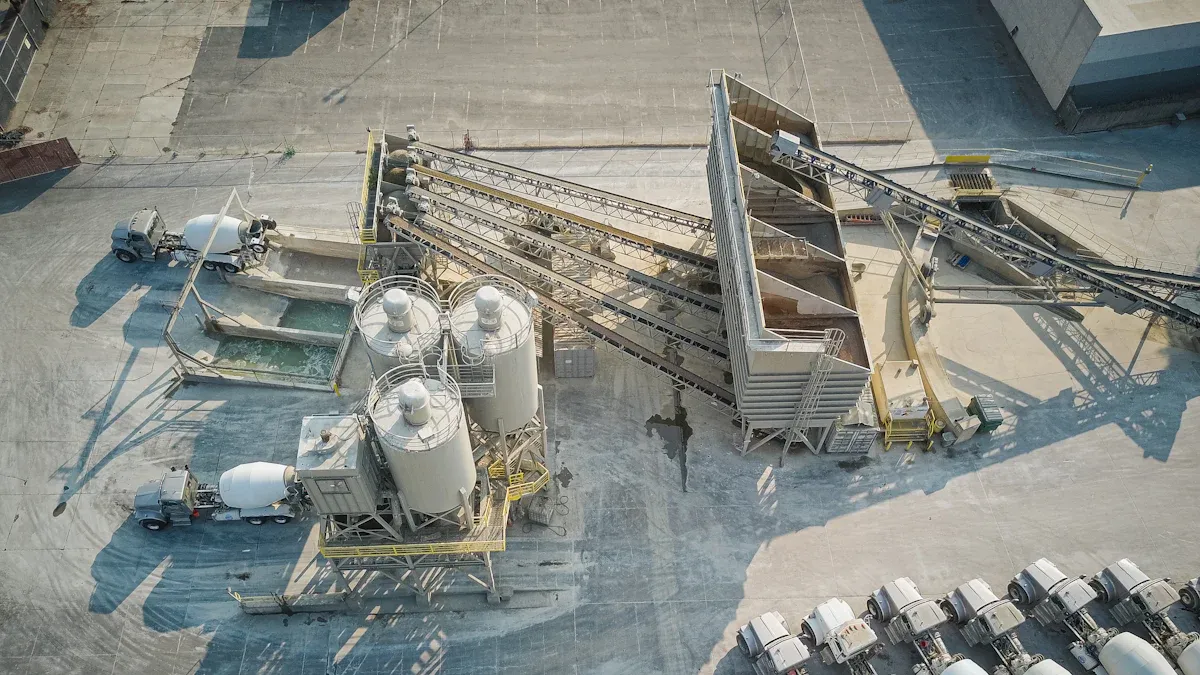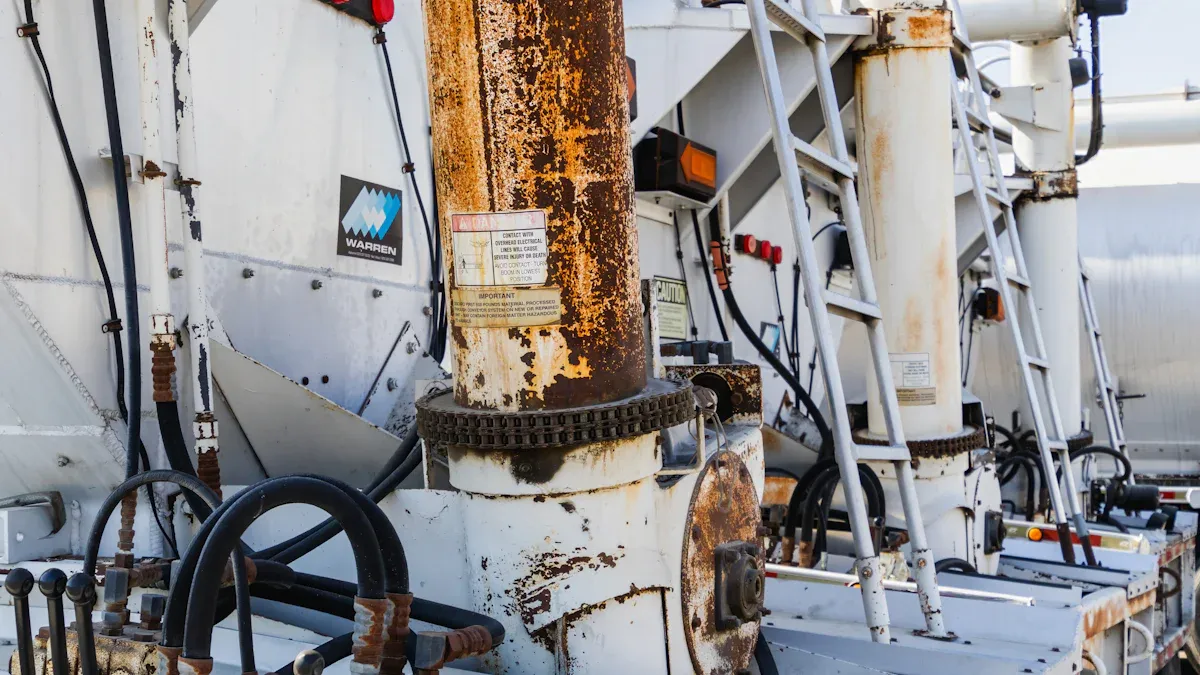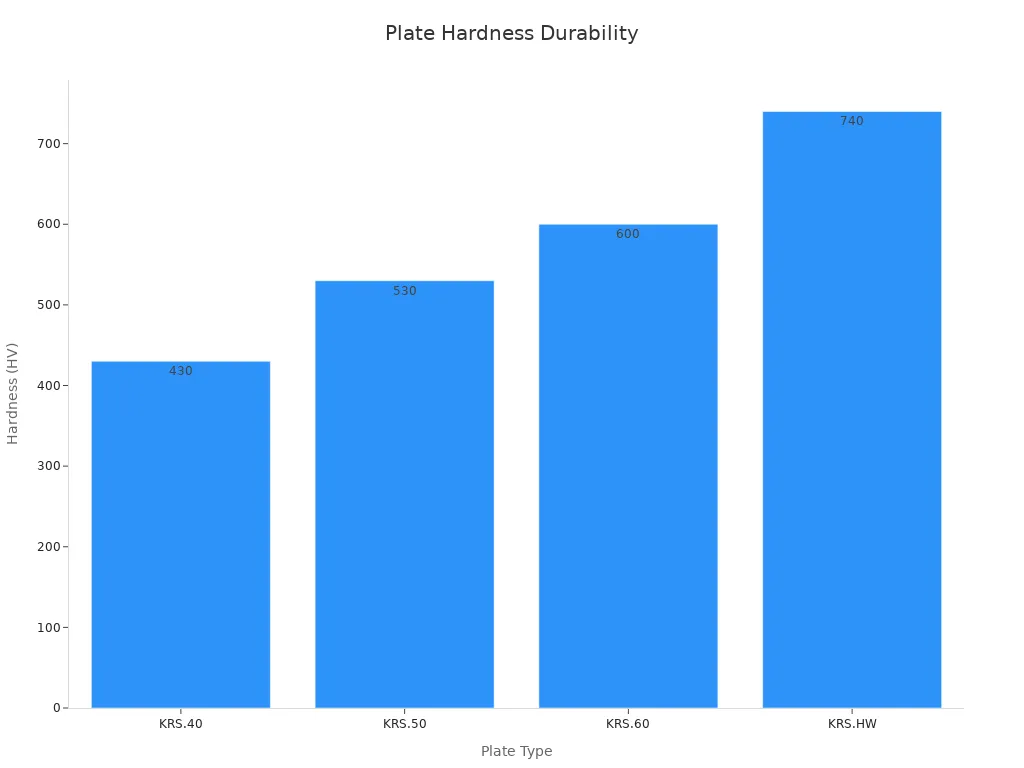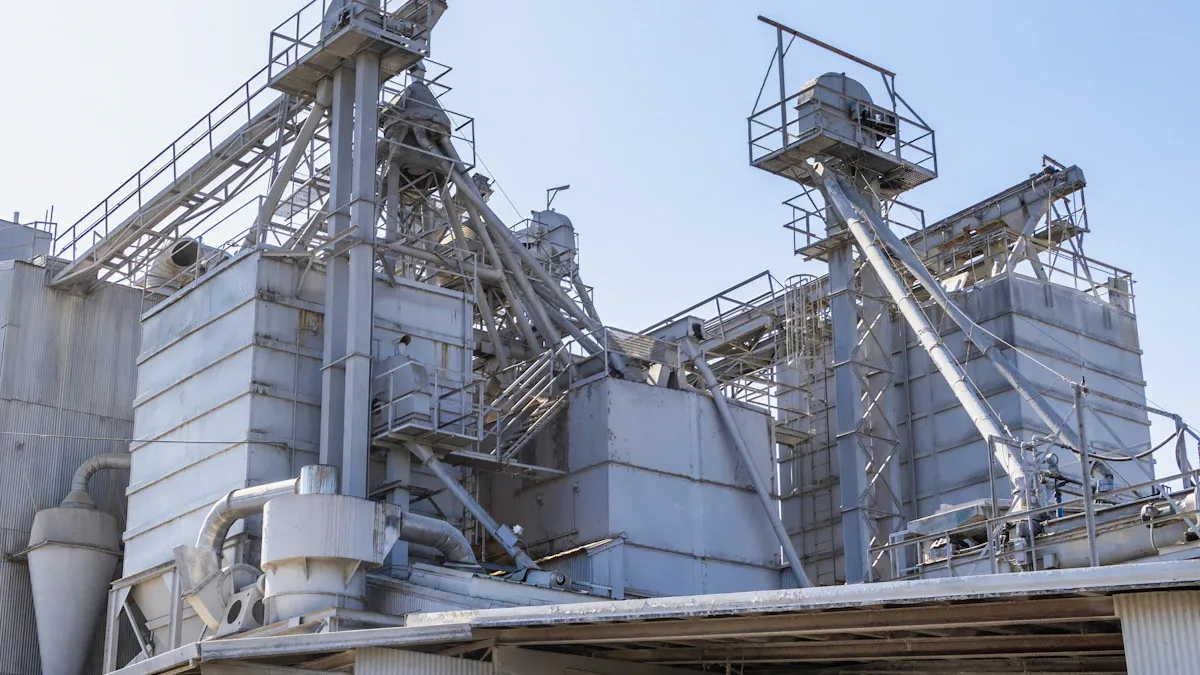
Wear parts are critical components of any concrete mixing plant. These include mixer blades, mixing arms, wear liners, and discharge gates. Each of these parts ensures smooth operations and helps you achieve consistent concrete production. Without these components, the efficiency of your mixing process drops significantly.
By maintaining wear parts, you can reduce downtime and extend the lifespan of your equipment. Neglecting them increases operational costs and lowers the quality of your concrete. Regular inspections and timely replacements help you avoid unnecessary disruptions.
Wear parts are essential components of concrete batching plants that endure constant friction, impact, and abrasion during operations. These parts include mixer blades, mixing arms, wear liners, discharge gates, seals, bearings, and spacer rings. Each plays a critical role in maintaining the efficiency of your concrete mixing plant.
For example, mixer blades and arms ensure thorough mixing of cement, aggregates, and water, while wear liners protect the interior surfaces of the mixer from damage. Discharge gates regulate the flow of ready-mix concrete, ensuring smooth delivery to the next stage of production.
Tip: Regularly inspect these wear parts to prevent unexpected failures and costly downtime.
Wear parts work together to ensure the smooth operation of your concrete batching plants. Mixer blades and arms agitate the materials, creating a homogeneous mix. Wear liners shield the mixer’s interior from abrasive materials like cement and aggregates, extending its lifespan. Discharge gates control the flow of concrete, ensuring precise delivery to trucks or silos.
The durability of these parts directly impacts the performance of your concrete mixer. High-quality wear parts reduce maintenance needs and improve the consistency of your concrete output. For instance, using chromium alloy blades can withstand heavy-duty mixing and last longer than standard steel blades.
A study revealed that replacing rubber skirting with Snap-Loc skirting reduced spillage and maintenance costs significantly. Similarly, Redi-Liner ceramic panels outlasted steel plates, saving time and money. These examples highlight how investing in durable wear parts can enhance your plant’s efficiency.
Wear and tear in concrete mixer spare parts occur due to several factors:
- Abrasion: Continuous contact with rough materials like aggregates and cement erodes surfaces over time.
- Impact: High-speed mixing and discharge processes create repeated stress on mixer blades and discharge gates.
- Corrosion: Moisture and chemicals in cement can corrode metal parts, reducing their lifespan.
- Aging: Prolonged use leads to natural degradation, especially in seals, bearings, and conveyor belts.
| Equipment Type | Key Features |
|---|---|
| Custom Equipment | Tailor-made solutions to fit processing needs, addressing wear and tear. |
| High-Speed Choppers | Built-to-last design that insulates shaft seals and bearings from wear. |
| Bolted Agitator | Heavy-duty design for abrasive applications, allowing for easy blade replacement. |
Understanding these causes helps you take preventative measures, such as using wear-resistant materials and conducting regular inspections .
Note: Replacing worn-out parts promptly prevents further damage to your concrete batching plants and ensures consistent production quality.

Mixing blades and arms are the heart of your concrete batching plants. These components ensure that cement, aggregates, and water blend into a uniform mixture. High-quality blades and arms improve the consistency of your concrete and reduce the time required for mixing.
You should choose blades made from durable materials like chromium alloy or Ni-CR alloys. These materials resist abrasion and last longer, even under heavy-duty operations. Regular inspection of these parts is essential. Worn-out blades or arms can lead to uneven mixing, which compromises the quality of your concrete.
Tip: Replace mixing blades and arms as soon as you notice uneven wear patterns to maintain optimal performance.
Liners and wear plates protect the interior surfaces of your concrete mixing plant from abrasion caused by rough materials like aggregates. These parts act as a shield, extending the lifespan of your equipment and reducing maintenance costs.
Different types of wear plates are available, each suited for specific applications. For example:
| Wearing plate | Hardness (HV) | Recommended Application |
|---|---|---|
| KRS.40 | up to 430 | Low abrasiveness materials like limestone. |
| KRS.50 | up to 530 | Medium abrasiveness materials like stone. |
| KRS.60 | up to 600 | Extremely abrasive materials. |
| KRS.HW | ~740 | High abrasive wear, reducing replacement intervals. |

Selecting the right liner or wear plate depends on the materials you process. For highly abrasive materials, KRS.HW plates are ideal. They offer superior durability and reduce the frequency of replacements.
Discharge gates and chutes control the flow of concrete from the mixer to the next stage of production. These components must withstand constant impact and abrasion. High-quality discharge gates ensure smooth delivery, preventing delays and spillage.
You should inspect these parts regularly for cracks or uneven wear. Damaged gates or chutes can lead to inconsistent concrete flow, affecting the overall efficiency of your concrete batching plants. Opt for gates made from wear-resistant materials to minimize maintenance needs and extend their lifespan.
Note: Proper alignment of discharge gates and chutes is crucial for efficient operation. Misaligned parts can cause blockages and reduce productivity.
Seals, bearings, and spacer rings are small but vital components in concrete batching plants. T hese parts ensure smooth operation by reducing friction, preventing leaks, and maintaining alignment within the machinery. Without them, your equipment could face frequent breakdowns and reduced efficiency.
Seals prevent the leakage of materials like cement paste and water from the mixer. They also protect internal components from dust and debris. A damaged seal can lead to contamination, which affects the quality of your concrete. Regularly inspect seals for cracks or wear to avoid costly repairs.
Bearings reduce friction between moving parts, ensuring smooth rotation and movement. In concrete batching plants, they support heavy loads and withstand constant motion. Worn-out bearings can cause vibrations, noise, and even damage to other components. Lubricating bearings regularly extends their lifespan and keeps your plant running efficiently.
Spacer rings maintain proper alignment between components, ensuring they work together seamlessly. Misaligned parts can lead to uneven wear and tear, reducing the lifespan of your equipment. Using high-quality spacer rings minimizes this risk and improves overall performance.
Tip: Always choose seals, bearings, and spacer rings made from durable materials. High-quality components reduce maintenance needs and improve the reliability of your co ncrete batching plants.
By paying attention to these often-overlooked parts, you can enhance the efficiency and longevity of your equipment. Regular maintenance and timely replacements ensure your plant operates at its best.
When selecting wear parts for your concrete batching plants, material quality plays a crucial role. High-quality components ensure durability and reduce the frequency of replacements. Materials like chromium alloy and Ni-CR alloys are excellent choices for wear-resistant parts. These materials withstand the constant abrasion and impact caused by cement and aggregates during mixing.
For example, mixer blades made from chromium alloy last longer and maintain their shape even under heavy-duty operations. Ni-CR alloys, on the other hand, offer superior resistance to corrosion, making them ideal for environments with high moisture or chemical exposure. Choosing durable materials not only extends the lifespan of your concrete mixer spare parts but also ensures consistent performance.
Tip: Always prioritize wear parts with a high-quality guarantee to minimize downtime and maintenance costs.
Not all wear parts fit every type of concrete mixer. Ensuring compatibility with your specific mixer brand is essential for seamless operation. Whether you use a twin shaft mixer or a planetary mixer, selecting parts designed for your equipment ensures proper alignment and functionality.
Many manufacturers produce wear parts tailored to popular mixer brands. For instance, some suppliers specialize in components for well-known brands like Liebherr, Sicoma, or BHS. Using compatible parts reduces the risk of operational issues, such as misalignment or uneven wear. It also simplifies the installation process, saving you time and effort.
Note: Check your mixer’s specifications before purchasing spare parts to avoid compatibility issues.
While upfront cost is an important consideration, you should also evaluate the long-term value of wear parts. High-quality components may have a higher initial price, but they often lead to significant savings over time. Durable parts reduce maintenance needs, minimize downtime, and enhance the overall efficiency of your concrete batching plants.
Here’s a comparison to help you weigh the cost-benefit of different options:
| Factor | Description |
|---|---|
| Upfront Cost | High-quality equipment may have a higher initial price but can lead to savings through efficiency. |
| Maintenance Costs | Regular maintenance extends equipment lifespan and enhances performance, impacting total ownership cost. |
| Resale Value | Well-maintained machinery retains value, affecting financial outlay during resale or trade-in. |
Additionally, consider whether to invest in new or used parts. New parts offer reliability and often come with a warranty, while used parts may be more affordable and depreciate slower. Routine preventive maintenance can further enhance the value of both options.
Tip: Focus on the total cost of ownership rather than just the upfront price. Investing in high-quality components pays off in the long run.
Choosing the right supplier for wear parts can make or break the efficiency of your concrete mixing plant. A supplier's reputation and support services directly impact the quality of the parts you receive, as well as your overall operational success. Reliable suppliers ensure consistent product quality, timely deliveries, and responsive customer service. On the other hand, poor supplier performance can lead to costly disruptions and long-term damage to your business.
A supplier's reputation reflects their track record in delivering high-quality products and services. Trustworthy suppliers prioritize durability and precision in their wear parts, ensuring they meet your plant's specific needs. They also maintain transparent communication, keeping you informed about product availability and delivery timelines.
However, unreliable suppliers can cause significant problems. Studies show that supplier-related issues account for up to 50% of product recalls, a s reported by 61% of manufacturing businesses. These recalls often result in financial losses ranging from $8 million to $50 million. Beyond monetary costs, poor supplier performance can delay production schedules, harm your company's reputation, and reduce customer satisfaction.
Tip: Always research a supplier's history and customer reviews before making a purchase. A strong reputation often indicates consistent quality and reliability.
Support services are just as important as the quality of the wear parts themselves. A good supplier offers technical assistance, troubleshooting guidance, and after-sales support to help you maintain your equipment. They also provide clear installation instructions and maintenance tips, ensuring you get the most out of your wear parts.
Suppliers with robust support systems can help you address unexpected challenges quickly. For example, if a part fails prematurely, a responsive supplier will offer a replacement or repair solution without delay. This level of support minimizes downtime and keeps your operations running smoothly.
In contrast, suppliers with poor support can leave you stranded during critical moments. Delayed responses or inadequate solutions can disrupt your production process and increase operational costs.
When selecting a supplier, focus on these key factors:
- Product Quality: Look for suppliers who use durable materials like chromium alloy or Ni-CR alloys. High-quality parts reduce wear and tear, saving you money in the long run.
- Customer Reviews: Check online reviews and testimonials to gauge customer satisfaction. Positive feedback often indicates reliable service and quality products.
- Industry Experience: Choose suppliers with a proven track record in the concrete mixing industry. Experienced suppliers understand the unique challenges of your operations.
- After-Sales Support: Ensure the supplier offers comprehensive support services, including technical assistance and warranty coverage.
Note: Building a long-term relationship with a reputable supplier can lead to better pricing, priority service, and customized solutions for your plant.
By prioritizing supplier reputation and support, you can secure high-quality wear parts that enhance your plant's efficiency and longevity. A reliable supplier acts as a partner in your success, helping you overcome challenges and achieve consistent production results.

Regular inspections are essential to keep your concrete mixing plant running efficiently. By identifying potential issues early, you can prevent costly downtime and extend the lifespan of your equipment. Follow these steps to create an effective inspection routine:
Take inventory of all equipment, including mixers, conveyors, and silos.
Identify risks and failure points based on usage patterns and past performance.
Develop a maintenance schedule with daily, weekly, monthly, and annual tasks.
Assign responsibilities to trained personnel for each maintenance task.
Implement preventive measures like lubrication and timely replacement of wear parts.
Using advanced inspection methods can also help detect early signs of wear. For example:
| NDT Method | Description |
|---|---|
| Ultrasonic Testing (UT) | Detects weld issues, corrosion, and wall thickness variations in structures and pipelines. |
| Eddy Current Testing | Ensures quality and safety by inspecting materials like cables and alloys. |
| Ground Penetrating Radar | Identifies underground structures and utilities, especially useful in concrete applications. |
Tip: Schedule inspections during non-peak hours to minimize disruptions to your operations.
Recognizing the signs of wear part degradation ensures timely replacements and avoids further damage. Look for these indicators:
Uneven Mixing: Worn-out blades or arms may cause inconsistent concrete mixtures.
Cracks or Deformation: Visible damage on liners, plates, or discharge gates signals the need for replacement.
Increased Noise or Vibration: Faulty bearings or misaligned parts often produce unusual sounds.
Material Leakage: Damaged seals can lead to leaks, affecting the quality of your concrete.
Ignoring these signs can lead to equipment failure and production delays. Always replace worn parts promptly to maintain efficiency.
Proper installation of wear parts is crucial for optimal performance. Misaligned or poorly installed components can wear out faster and reduce efficiency. Follow these guidelines for best results:
| Aspect | Description |
|---|---|
| Proper Installation | Ensure parts are fastened correctly to prevent misalignment and premature wear. |
| Routine Checks | Inspect newly installed parts to confirm they are functioning as expected. |
| Timely Lubrication | Apply lubrication as recommended to reduce friction and extend part life. |
| Address Common Issues | Familiarize yourself with potential problems to resolve them quickly and avoid further damage. |
Note: Always refer to the manufacturer’s manual for specific installation instructions. Properly installed parts not only last longer but also improve the overall performance of your plant.
Preventative maintenance keeps your concrete mixing plant running efficiently and extends the lifespan of wear parts. By following a structured maintenance routine, you can avoid unexpected breakdowns and costly repairs. Here are some essential practices to include in your maintenance plan:
Scheduled Inspections: Perform routine checks on all components, including mixer blades, liners, and seals. Early detection of wear or damage prevents small issues from escalating.
Cleaning and Lubrication: Keep your equipment clean and free of debris. Apply lubrication to moving parts like bearings to reduce friction and wear.
Component Replacements: Replace worn-out parts before they fail. Proactive replacements ensure consistent performance and prevent downtime.
Calibration and Testing: Regularly calibrate and test your equipment to maintain accuracy and efficiency. This step ensures your plant produces high-quality concrete.
Documentation: Maintain detailed records of all maintenance activities. These records help you track wear patterns and plan future replacements.
Tip: Use a maintenance checklist to ensure no critical tasks are overlooked.
Consistent preventative maintenance offers several benefits. Well-maintained equipment operates more efficiently, reducing energy consumption and production time. It also minimizes downtime by addressing potential issues before they cause breakdowns. Additionally, regular maintenance saves money by preventing major failures and expensive repairs.
Another key advantage is safety. Regular checks ensure your machinery operates safely, protecting both your workers and your investment. For example, inspecting seals and bearings reduces the risk of leaks or mechanical failures that could lead to accidents.
By prioritizing preventative maintenance, you can improve your plant’s efficiency, reduce costs, and extend the lifespan of your wear parts. A little effort today can save you significant time and money in the future.
High-quality wear parts significantly enhance the performance of your concrete mixing plant. Durable components, such as mixer blades and seals, ensure smooth operations and reduce the risk of unexpected breakdowns. This reliability directly improves construction efficiency by minimizing interruptions during production.
Real-world examples highlight the impact of using superior parts. A semiconductor plant in Asia achieved a 30% reduction in unscheduled maintenance and a 20% boost in production yield after upgrading to high-quality seals. Similarly, a European facility reported a 25% improvement in overall equipment efficiency (OEE) due to fewer particle generation events. In North America, a manufacturer saved over $1.2 million annually by reducing downtime related to seal failures, achieving a 40% decrease in downtime. These results demonstrate how investing in quality parts can enhance the performance of your operations.
Using high-quality concrete mixer spare parts reduces downtime and lowers maintenance expenses. Durable parts last longer, minimizing the need for frequent replacements. This durability also reduces labor costs associated with maintenance tasks. For example, wear-resistant mixer blades and liners can withstand the abrasive nature of cement and aggregates, extending their operational lifespan.
Investing in premium replacement parts ensures your equipment operates efficiently for longer periods. This approach not only saves money but also prevents disruptions that could delay your projects. By choosing reliable components, you can focus on production rather than constant repairs.
The quality of your wear parts directly affects the quality of your concrete. High-quality mixer blades and arms ensure thorough mixing of cement, aggregates, and water, resulting in a consistent and uniform mixture. This consistency is crucial for meeting construction standards and delivering reliable results.
Damaged or low-quality parts can lead to uneven mixing, which compromises the strength and durability of your concrete. By using superior components, you can maintain high product standards and build trust with your clients. Additionally, well-maintained parts reduce contamination risks, ensuring your concrete meets the required specifications every time.
Tip: Regularly inspect and replace worn parts to maintain consistent product quality and avoid costly rework.
Investing in high-quality wear parts significantly extends the lifespan of your concrete mixing equipment. Durable components reduce the strain on your machinery, allowing it to operate efficiently for longer periods. This longevity not only saves you money but also ensures your plant remains productive over time.
Wear parts like mixer blades, liners, and seals play a critical role in protecting your equipment from damage. For example, wear-resistant liners shield the mixer’s interior from abrasive materials, preventing costly repairs. Similarly, high-quality seals stop leaks that could lead to corrosion or contamination. By using these robust parts, you minimize wear and tear on the entire system.
Tip: Schedule regular maintenance to maximize the lifespan of your wear parts and equipment.
Properly maintained wear parts also reduce the risk of unexpected breakdowns. When components like bearings and spacer rings function smoothly, they prevent unnecessary stress on other parts of the machine. This balance keeps your equipment running at peak performance and avoids costly downtime.
Here’s how high-quality wear parts contribute to longer equipment life:
| Wear Part | Benefit |
|---|---|
| Mixer Blades | Ensures consistent mixing, reducing uneven wear on the mixer. |
| Liners and Wear Plates | Protects internal surfaces from abrasion, extending the mixer’s lifespan. |
| Seals and Bearings | Prevents leaks and reduces friction, avoiding damage to moving parts. |
By prioritizing durable materials like chromium alloy or Ni-CR alloys, you ensure your equipment withstands the harsh conditions of concrete production. These materials resist abrasion, impact, and corrosion, making them ideal for heavy-duty operations.
Note: Replacing worn parts promptly prevents further damage and keeps your equipment in excellent condition.
Using high-quality wear parts is a smart investment. It protects your machinery, reduces maintenance costs, and ensures your plant operates efficiently for years to come.
Wear parts play a vital role in maintaining the efficiency and longevity of your concrete mixing plant. High-quality parts ensure smooth operations, reduce downtime, and improve the quality of your concrete. By investing in durable components, you protect your equipment and enhance its performance over time.
To keep your plant running efficiently, adopt proven maintenance strategies. For example:
| Strategy | Description | Actionable Steps |
|---|---|---|
| Predictive Maintenance | Uses data to predict equipment failures, reducing unexpected downtime. | Implement condition monitoring tools and an integrated maintenance management system. |
| Optimize Inventory Management | Ensures availability of critical parts to prevent delays in replacements. | Maintain an organized inventory and establish supplier relationships for quick access to parts. |
| Enhance Staff Training and Awareness | Trained staff can identify issues early, preventing downtime. | Conduct regular training sessions and use simulation tools for emergency scenarios. |
| Implement Redundancy in Critical Systems | Backup systems ensure operations continue during failures. | Identify critical systems and components that require redundancy. |
You can maximize your plant’s efficiency by conducting regular inspections, choosing reliable suppliers, and prioritizing preventative maintenance. These steps ensure your equipment operates at its best, saving you time and money in the long run.
You should inspect wear parts weekly to identify early signs of damage. For heavily used plants, daily checks are better. Regular inspections prevent unexpected breakdowns and ensure consistent performance.
Tip: Create a maintenance schedule to track inspections and replacements easily.
Chromium alloy and Ni-CR alloys are excellent choices. These materials resist abrasion, impact, and corrosion, making them ideal for heavy-duty operations. High-quality materials extend the lifespan of your equipment.
No, not all wear parts fit every mixer. Always check compatibility with your specific mixer brand. Using the wrong parts can cause misalignment, uneven wear, and reduced efficiency.
Note: Refer to your mixer’s manual for exact specifications.
Look for uneven mixing, cracks, increased noise, or material leakage. These signs indicate wear part degradation. Replacing parts promptly prevents further damage and ensures smooth operations.
Preventative maintenance reduces downtime, extends equipment lifespan, and improves safety. It also saves money by addressing small issues before they escalate into costly repairs.
Reminder: Keep a checklist to ensure no maintenance task is overlooked.